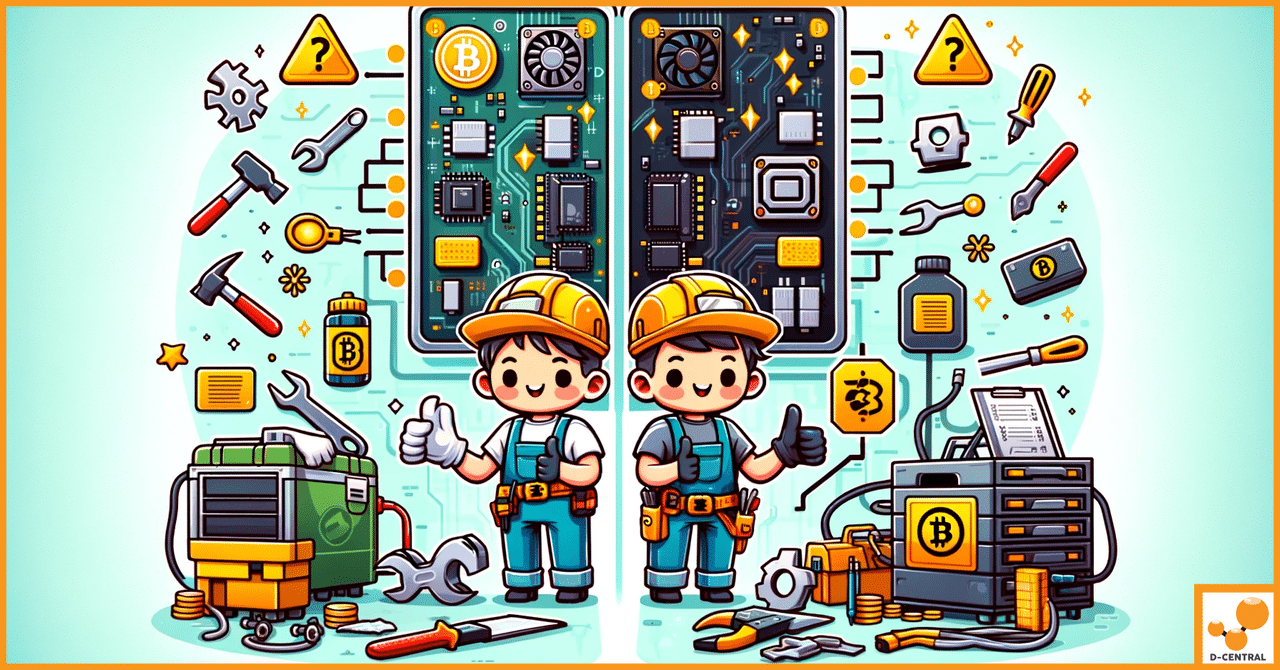
The Bitmain APW3 PSU vs. Other Mining Power Supply Units
Cryptocurrency mining has evolved into a highly competitive and energy-intensive industry, where the efficiency of every component can significantly impact
4479 Desserte Nord Autoroute 440, Laval, QC H7P 6E2

The landscape of Bitcoin mining has undergone a remarkable transformation since its inception, evolving from a niche activity accessible to tech enthusiasts into a sophisticated industry driven by cutting-edge technology. This evolution has been marked by significant milestones, each representing a leap forward in how we approach the mining of the world’s premier cryptocurrency.
In the early days, Bitcoin mining was a relatively simple affair. Enthusiasts could participate using basic computing hardware, such as CPUs and GPUs, commonly found in personal computers. This accessibility allowed a broad range of individuals to contribute to the Bitcoin network, reinforcing its decentralized nature. However, as Bitcoin gained popularity and its network complexity increased, the need for more efficient mining methods became apparent.
This necessity gave birth to the era of USB miners, compact devices that marked the beginning of specialized mining hardware. These small, plug-and-play devices offered a glimpse into the future of mining, where efficiency and compactness would become key. Despite their limited power compared to later technologies, USB miners played a crucial role in democratizing Bitcoin mining, allowing individuals to participate without significant investment.
The journey from these humble beginnings to the sophisticated mining rigs of today has been driven by continuous innovation and a community dedicated to optimizing and refining the mining process. At the forefront of this evolution stands the Bitaxe project, a beacon of innovation in the realm of compact mining hardware. The Bitaxe initiative represents a significant leap in small-scale mining, offering powerful, efficient, and accessible mining solutions that stand to redefine the landscape once again.
This article aims to trace the journey of small-scale mining, from the early days of USB miners to the cutting-edge Bitaxe project. We will explore how these developments have impacted the Bitcoin landscape, focusing on the technological advancements, the growing community of miners, and the ongoing quest for efficiency and decentralization. Join us as we delve into the fascinating world of Bitcoin mining, where the past and future converge to shape a dynamic and ever-evolving industry.
The genesis of small-scale Bitcoin mining can be traced back to the advent of USB miners, a pivotal development that marked the industry’s first foray into compact, specialized mining hardware. These devices, small enough to be plugged into a USB port on any standard computer, represented a significant departure from the CPU and GPU mining that dominated the early Bitcoin landscape. USB miners were not just a technological innovation; they symbolized the democratization of Bitcoin mining, making it accessible to a broader audience beyond the tech-savvy early adopters.
USB Bitcoin miners emerged as a practical solution for individuals interested in participating in the mining process without the need for large-scale, expensive setups. These devices were relatively affordable and user-friendly, offering a plug-and-play experience that lowered the barriers to entry into the mining world. They allowed enthusiasts to experiment with mining, learn the ropes, and contribute to the Bitcoin network, all from the comfort of their own homes.
Despite their groundbreaking role in the evolution of Bitcoin mining, USB miners were not without limitations. Their computational power, while impressive at the time, was modest compared to the increasingly complex demands of the Bitcoin network. As the difficulty of mining blocks increased, USB miners gradually became less effective, offering lower hash rates and becoming less economically viable as primary mining tools.
However, the contributions of USB miners to the Bitcoin mining community were significant and long-lasting. They served as an educational tool for many budding miners, providing a hands-on introduction to the concepts and processes involved in Bitcoin mining. USB miners also fostered a sense of community among miners, as enthusiasts shared tips, troubleshooting advice, and experiences, laying the groundwork for the collaborative spirit that characterizes the Bitcoin mining community today.
The limitations of USB miners inevitably led to the pursuit of more advanced and efficient mining solutions. This transition was driven by the community’s growing understanding of Bitcoin mining’s technical and economic aspects, coupled with rapid advancements in mining technology. The quest for more power-efficient and cost-effective mining hardware led to the development of more sophisticated compact mining solutions, such as ASIC (Application-Specific Integrated Circuit) miners.
These new generations of compact miners offered significantly higher hash rates and greater energy efficiency than their USB predecessors, marking a leap forward in the capabilities of small-scale mining hardware. This evolution reflected the maturing of the Bitcoin mining industry, as it moved from a hobbyist activity to a more serious and technically demanding endeavor. The shift towards more advanced compact mining solutions paved the way for projects like Bitaxe, which would take the concept of small-scale, efficient mining to new heights, further transforming the Bitcoin mining landscape.
As the Bitcoin mining landscape continued to evolve, a new chapter began with the emergence of Nerdminers. These devices represented a significant technological leap, bridging the gap between the basic USB miners and the more sophisticated ASIC technology. Nerdminers were a game-changer in the realm of compact mining hardware, offering enhanced capabilities while maintaining the ethos of accessibility and community-driven innovation.
Nerdminers were designed to cater to the needs of enthusiasts who sought more power than USB miners could provide but were not ready or able to invest in full-scale ASIC setups. These devices struck a balance, offering improved hash rates and energy efficiency while remaining relatively affordable and user-friendly. They were compact, yet powerful enough to make small-scale mining more viable and profitable, even as the Bitcoin network’s difficulty increased.
The technical advancements in Nerdminers were notable. They incorporated more advanced chipsets and better heat management systems, addressing some of the key limitations of USB miners. This leap in technology translated into better performance, allowing miners to achieve higher hash rates and better energy efficiency. The design of Nerdminers also evolved, with a focus on durability and ease of use, making them suitable for continuous operation without the need for extensive technical knowledge.
The reception of Nerdminers within the mining community was overwhelmingly positive. They were seen as a natural progression from USB miners, offering a more serious mining experience without the intimidating complexity and cost of full-scale ASIC rigs. Nerdminers appealed to a broad spectrum of miners, from hobbyists looking to upgrade their mining setup to newcomers seeking an entry point into the world of Bitcoin mining.
Nerdminers played a crucial role in popularizing small-scale mining. They made the process more accessible and financially viable for a larger group of people, thereby contributing to the decentralization of Bitcoin mining. By lowering the barriers to entry, Nerdminers helped diversify the mining community, bringing in new perspectives and ideas.
Their impact extended beyond just hardware; Nerdminers fostered a culture of innovation and collaboration within the mining community. Forums and online groups flourished, with miners sharing tips, modifications, and custom cooling solutions. This collaborative environment was instrumental in driving further advancements in mining technology and techniques.
In essence, Nerdminers were more than just a step in the technological evolution of Bitcoin mining hardware; they were a catalyst for community growth and engagement. Their introduction marked a significant milestone in the journey towards more inclusive, efficient, and decentralized Bitcoin mining, setting the stage for the next generation of mining innovations, such as the Bitaxe project.
The Bitaxe project represents a significant leap forward in the realm of Bitcoin mining, embodying a philosophy deeply rooted in the principles of open-source development and community empowerment. This initiative stands out as a beacon of innovation, aiming to democratize Bitcoin mining by making it accessible and feasible for enthusiasts and hobbyists alike. The core objective of the Bitaxe project is to break down the barriers that have traditionally limited mining to industrial-scale operations, thereby fostering a more decentralized and inclusive mining landscape.
At the heart of the Bitaxe project lies a commitment to transparency and collaboration. By embracing open-source principles, Bitaxe empowers individuals to participate in the mining process, offering them the tools and knowledge to build, modify, and operate their own mining hardware. This approach not only encourages innovation and experimentation within the community but also aligns closely with the original ethos of Bitcoin – decentralization and empowerment of the individual.
The Bitaxe 1366 and Bitaxe 1397 models are the flagship products of the Bitaxe project, each designed with specific user needs in mind.
The open-source nature of the Bitaxe project is a game-changer in the evolution of Bitcoin mining hardware. By making the designs and specifications of their hardware publicly available, Bitaxe has set a new standard in the industry. This open-source approach has several significant implications:
The Bitaxe project, with its open-source philosophy and innovative hardware models, is not just advancing the technology of mining hardware; it is reshaping the entire landscape of Bitcoin mining. It stands as a symbol of a more inclusive, decentralized, and collaborative future in the world of cryptocurrency.
The Bitaxe project has been a revolutionary force in the world of Bitcoin mining, particularly in its mission to make mining more accessible and feasible for enthusiasts and hobbyists. This initiative has effectively democratized the mining process, breaking down the barriers that once made it an exclusive domain for industrial-scale miners.
Bitaxe’s approach to democratizing mining involves several key strategies:
The widespread adoption of Bitaxe’s mining solutions has significant implications for the decentralization of Bitcoin mining. By enabling more individuals and small groups to mine Bitcoin, Bitaxe is helping to distribute the mining power more evenly across the network. This decentralization is crucial for the health and security of the Bitcoin blockchain, as it reduces the risk of centralization and the potential for any single entity to exert undue influence over the network.
As we look towards the future, the landscape of small-scale Bitcoin mining is poised for significant evolution. The trend is clear: compact mining hardware will continue to become more powerful, efficient, and user-friendly. Innovations in chip design and energy efficiency are expected to drive this progress, making mining rigs like those offered by Bitaxe even more effective and accessible to the average user.
The integration of AI and machine learning algorithms into mining hardware is another exciting prospect. These technologies could optimize mining operations, adjust to market fluctuations in real-time, and provide enhanced security features, further empowering small-scale miners.
Small-scale mining holds immense potential in supporting and stabilizing the Bitcoin network. As more individuals and small groups engage in mining activities, the network becomes more decentralized, enhancing its resilience and security. This decentralization is crucial in maintaining the democratic ethos of Bitcoin, ensuring that no single entity can monopolize the mining process.
Moreover, small-scale mining can play a pivotal role in the adoption and normalization of Bitcoin. As more people become miners, they also become advocates and educators within their communities, spreading awareness and understanding of Bitcoin and its underlying technologies.
Initiatives like Bitaxe are not just about providing hardware; they are catalysts for a broader movement. By lowering the barriers to entry and championing the principles of decentralization, projects like Bitaxe are shaping the future of Bitcoin mining. They are creating a more inclusive, democratic, and resilient network.
In conclusion, the future of small-scale mining looks bright, with technological advancements and initiatives like Bitaxe playing a crucial role. These developments are not just significant for miners but for the entire Bitcoin ecosystem, as they contribute to a more decentralized, secure, and robust network. The journey from USB miners to the innovative Bitaxe project is just the beginning, and the road ahead is filled with exciting possibilities for the world of Bitcoin mining.
As we reflect on the journey from the humble beginnings of USB miners to the pioneering Bitaxe project, it’s clear that the world of Bitcoin mining has undergone a remarkable transformation. This evolution has not only been technological but also philosophical, shifting towards a more inclusive and decentralized approach.
The progression from basic USB miners to the advanced Bitaxe 1366 and 1397 models illustrates a significant leap in mining technology. These developments have made it possible for individuals and small groups to participate in Bitcoin mining, a domain once dominated by large-scale operations. This shift is crucial for the health and democratization of the Bitcoin network, ensuring its resilience and adherence to its foundational ethos.
Small-scale mining plays an integral role in the broader Bitcoin ecosystem. It’s not just about the mining itself but about the community, education, and innovation that come with it. Projects like Bitaxe are at the forefront of this movement, providing tools and platforms for anyone interested in contributing to the Bitcoin network.
We encourage readers to explore the world of small-scale mining. Whether you’re a seasoned miner or a newcomer to the field, there’s a place for you in this evolving landscape. By participating in small-scale mining, you’re not just engaging in a potentially profitable activity; you’re also contributing to the decentralization and strength of the Bitcoin network.
In conclusion, the rise of compact mining hardware like Bitaxe is more than a technological advancement; it’s a step towards a more inclusive and democratic Bitcoin future. As we continue to witness the growth and evolution of small-scale mining, it’s exciting to think about the possibilities it holds for the Bitcoin community and beyond.
DISCLAIMER: D-Central Technologies and its associated content, including this blog, do not serve as financial advisors or official investment advisors. The insights and opinions shared here or by any guests featured in our content are provided purely for informational and educational purposes. Such communications should not be interpreted as financial, investment, legal, tax, or any form of specific advice. We are committed to advancing the knowledge and understanding of Bitcoin and its potential impact on society. However, we urge our community to proceed with caution and informed judgment in all related endeavors.
Related Posts

Cryptocurrency mining has evolved into a highly competitive and energy-intensive industry, where the efficiency of every component can significantly impact

In the rapidly evolving world of cryptocurrency mining, Application-Specific Integrated Circuit (ASIC) miners have emerged as the linchpin of efficient

In the rapidly evolving world of cryptocurrency, Application-Specific Integrated Circuit (ASIC) miners have become the backbone of the industry. These